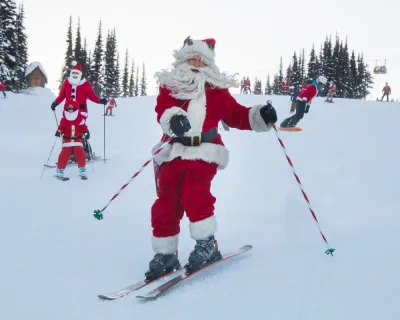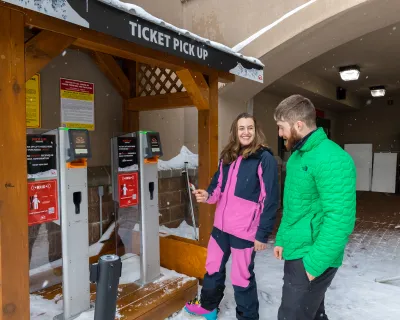
Then and now: Kimberley
Former mining town hits motherlode as popular ski town
The prospectors trudging through the thick bushes along Mark Creek were searching the mountains for minerals, not skiable terrain.
Just three kilometres from the present town of Kimberley, they struck gold - well more like galena - the lead zinc ore used in diodes and lead batteries used in the road hog your boards are strapped to each weekend.
WATCH: An introduction to Kimberley Alpine Resort.
That was 1891, the same year Nikola Tesla invented the Tesla coil and James Naismith invented the game of basketball, but this was the uncharted lands of the west and the world was hungry for minerals. The North Star Mine was the first claim staked for galena and the prospectors went to work extracting it.
From mines to a ski hill
It’s too bad the North Star guys didn’t keep prospecting. The motherlode was found across the valley by another group who opened the Sullivan Mine in 1892.
As people moved to the valley, the new town needed a name. In 1896, they decided to call it Kimberley after the impressive diamond mine in South Africa. By 1905, the North Star Mine was quiet but in hindsight that’s a good thing. The mine was directly under the slopes of Kimberley Alpine Resort.
Sullivan Mine however continued to extract ore for many years. The mine was the longest running underground mine in British Columbia, operating for more than 100 years and only shutting down in 2001. During that time, more than 65,000 people in the valley worked for the mine with tunnels snaking and criss-crossing about 500 kilometres under the slopes.
With the North Star Mine shut down, the slopes were perfect for a ski hill and opened in 1930 to the delight of many of the miners and their families. At that time, it was just a community hill with only a few amenities. Located just three kilometres from the centre of town, it was accessible by everyone with skis or toboggans.
Knowing that the mining industry would either run out of ore or demand for the product would fall off, Kimberley went about reinventing itself as a tourist destination in 1972. Jim Ogilvie, the mayor at the time thought there should be a gimmick to draw in the tourists.
Sign up to SnowSeekers enews
Get more of the snow stoke you love, with our free weekly newsletter.
Bavarian-themed town is born
Becoming the “Bavarian City of the Rockies,” enticed visitors away from the major highways to see this unique tourist attraction. Downtown Kimberley was transformed into a pedestrian-only street called the Platzl full of shops and restaurants with that European façade. The largest freestanding cuckoo clock in Canada was the centre of attention. That theme hung on for many years but much of it has been renovated.
It did the job. It put Kimberley on the roadside attraction map. The amusing clock is still on the Platzl and waits for coins to open the doors to let a comical yodeller out for a holler.
Part of the reinvention plan was to bring in the skiers in the winter. In 1979, the city secured 165 acres of land at the ski resort, allowing the ski society to expand and build the first two condos on the mountain. The next winter Kimberley hosted the Canada Winter Games, a pretty impressive accomplishment considering the population of the city is roughly 8,000.
All levels of government came together in 1980 offering money to improve the infrastructure of the resort. A new road named after local skiing ace, Gerry Sorensen worked its way to the base of the resort where the North Star Centre was added to the day lodge. A lodge was also added to the top of the mountain.
Anybody who had a mortgage in the late 1980s knows it was a tough time to have debt. Interest rates rose to 25 per cent and the Kimberley Ski Resort Society was forced into bankruptcy. The city purchased the mortgage from the bank and took ownership of the hill, saving at least 100 local jobs. Within the decade, an offer to purchase the resort came from the Resorts of the Canadian Rockies. Along with the Trickle Creek Golf Course and the campground, the resort was sold to RCR which had ambitious plans to create a mountain resort with hotels and lodges. Having the Canadian Rockies International Airport only 15 minutes away instantly made Kimberley Alpine resort the closest ski resort to an international airport.
Development boomed
The base of the resort filled in with chalets, lodges and homes while the Gerry Sorensen Way attracted development on the shoulder above the base. Many skiers don’t even notice the only accessible tunnel on the mountain as they tuck towards the North Star Express Chair. It’s not a mining tunnel, rather an access for cars and pedestrians linking to the accommodations on the north side of the slope. Eight golf courses and endless mountain trails keep people coming all year.
Today, skiers and boarders have five lifts to choose from to take them to 1,800 acres of terrain. On average, the resort gets five metres of “Purcell Powder” on more than 80 runs that include a nice mix of groomers, glades and slopes for beginners or experts. Après ski sees families comparing their days while gobbling baskets of fries at the Stemwinder Bar & Grill. Live music carries into the night.
From humble beginnings with lead zinc this ex-mining town, has turned into an award-winning ski town.
When you go
Ski & Stay: For more information on skiing, snowboarding, and accomodations head to the official Kimberley Alpine Resort website
Share: Show your stoke for the awesome history of Kimberley by sharing this page with your friends!
Why not continue the stoke?
Become a SnowSeekers member build your bucket list, and get exclusive access to deals and more.


















